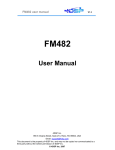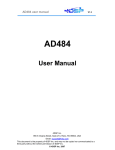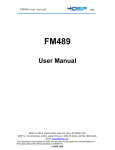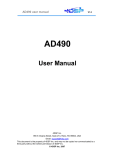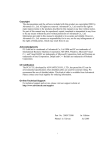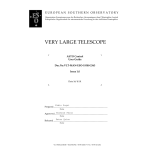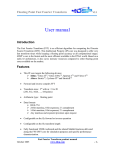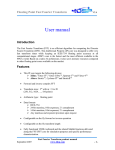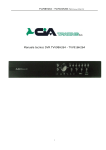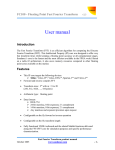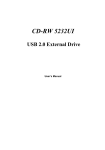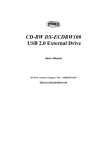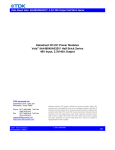Download FM480 User Manual
Transcript
FM480 USER MANUAL V1.0 FM480 User Manual 4DSP Inc. 1757 Fox Run road, Reno, NV 89509-0907, USA. Email: [email protected] This document is the property of 4DSP Inc. and may not be copied nor communicated to a third party without the written permission of 4DSP Inc. © 4DSP Inc. 2006 FM480 USER MANUAL V1.0 Revision History Date 03-22-06 March 2006 Revision Initial release Version 1.0 FM480 User Manual www.4dsp.com -2- FM480 USER MANUAL V1.0 Table of Contents 1 2 3 4 5 6 7 8 Acronyms and related documents................................................................................4 1.1 Acronyms..................................................................................................................4 1.2 Related Documents ..................................................................................................4 1.3 General description ..................................................................................................5 Installation.......................................................................................................................6 2.1 Requirements and handling instructions ..................................................................6 2.2 Firmware and software .............................................................................................6 Design..............................................................................................................................6 3.1 FPGA devices...........................................................................................................6 3.1.1 Virtex-II Pro device A ........................................................................................6 3.1.2 Virtex-4 device B...............................................................................................9 3.2 FPGA devices configuration ...................................................................................10 3.2.1 Flash storage ..................................................................................................10 3.2.2 CPLD device...................................................................................................10 3.2.3 JTAG...............................................................................................................12 3.3 Clocks.....................................................................................................................12 3.4 Memory resources ..................................................................................................13 3.4.1 QDR2 SRAM ..................................................................................................13 3.4.2 DDR2 SDRAM ................................................................................................13 3.5 Front Panel IO daughter card .................................................................................14 3.5.1 Virtex-4 device B to I/O front Panel daughter card .........................................14 (only available with daughter card purchase) .................................................................14 3.5.2 Power connection to the front panel I/O daughtercard ...................................16 Power requirements .....................................................................................................17 4.1 External power connector .......................................................................................18 Environment..................................................................................................................19 5.1 Temperature ...........................................................................................................19 5.2 Convection cooling .................................................................................................19 5.3 Conduction cooling .................................................................................................19 Safety.............................................................................................................................19 EMC................................................................................................................................19 Warranty ........................................................................................................................19 March 2006 FM480 User Manual www.4dsp.com -3- FM480 USER MANUAL V1.0 1 Acronyms and related documents 1.1 Acronyms ADC DAC DCI DDR DSP EPROM FBGA FPDP FPGA JTAG LED LVTTL LVDS LSB LVDS MGT MSB PCB PCI PLL PMC QDR SDRAM SRAM Analog to Digital Converter Digital to Analog Converter Digitally Controlled Impedance Double Data Rate Digital Signal Processing Erasable Programmable Read-Only Memory Fineline Ball Grid Array Front Panel Data Port Field Programmable Gate Array Join Test Action Group Light Emitting Diode Low Voltage Transistor Logic level Low Differential Data Signaling Least Significant Bit(s) Low Voltage Differential Signaling Multi-Gigabit Transceiver Most Significant Bit(s) Printed Circuit Board Peripheral Component Interconnect Phase Locked Loop PCI Mezzanine Card Quadruple Data rate Synchronous Dynamic Random Access memory Synchronous Random Access memory Table 1: Glossary 1.2 Related Documents • • • • • • IEEE Std 1386.1-2001 : IEEE Standard Physical and Environmental Layers for PCI Mezzanine Cards (PMC). ANSI/VITA 39-2003 : PCI-X for PMC and Processor PMC. ANSI/VITA 20-2001 : Conduction Cooled PMC. IEEE Std 1386-2001 : IEEE Standard for a Common Mezzanine Card (CMC) Family. Xilinx Virtex-4 user guide Xilinx PCI-X core datasheet March 2006 FM480 User Manual www.4dsp.com -4- FM480 USER MANUAL 1.3 V1.0 General description The FM480 is a high performance PMC dedicated to digital signal processing applications with high bandwidth and complex algorithms requirements. PCI-X and PCI backward compatible, the FM480 offers various interfaces, fast on-board memory resources and one Virtex-4 FPGA. It can be utilized, for example, to accelerate frequency-domain algorithms with off-the-shelf Intellectual Property cores for applications that require the highest level of performances. The FM480 is mechanically and electrically compliant to the standard and specifications listed in section 1.2 of this document. Figure 1: FM480 block diagram March 2006 FM480 User Manual www.4dsp.com -5- FM480 USER MANUAL V1.0 2 Installation 2.1 Requirements and handling instructions • The FM480 must be installed on a motherboard compliant to the IEEE Std 1386-2001 standard for 3.3V PMC Do not flex the board Observe SSD precautions when handling the board to prevent electrostatic discharges. Do not install the FM480 while the motherboard is powered up. • • • 2.2 Firmware and software Drivers, API libraries and a program example working in combination with a pre-programmed firmware for both FPGAs are provided. The FM480 is delivered with an interface to the Xilinx PCI core in the Virtex-II Pro device and an example VHDL design in the Virtex-4 device so users can start performing high bandwidth data transfers over the PCI bus right out of the box. For more information about software installation and FPGA firmware, please refer the FM480 Get Started Guide. 3 Design 3.1 FPGA devices The Virtex-II Pro and Virtex-4 FPGA devices interface to the various resources on the FM480 as shown on Figure 1. They also interconnect to each other via 86 general purpose pins and 2 clock pins. 3.1.1 3.1.1.1 Virtex-II Pro device A Virtex-II Pro device A family and package The Virtex-II Pro device is a XC2VP7 in a Fineline Ball Grid array with 672 balls (FF672). 3.1.1.2 Power PC embedded processor One IBM PowerPC RISC processor cores is available in the Virtex-II Pro device A. This core can be used to execute C based algorithms and control the logic resources implemented in the FPGA. 3.1.1.3 Virtex-II Pro device A external memory interfaces The Virtex-II Pro device A is connected to two 128Mbytes SDRAM devices with 16-bit data bus width. These memory resources can be used by the PowerPC core or can serve as data buffers. 3.1.1.4 PCI interface The Virtex-II Pro device A interfaces directly to the PCI bus via the PMC P1n, P2n and P3n connectors. An embedded PCI core from Xilinx is used to communicate over the PCI bus with the host system on the motherboard. PCI-X 64-bit 66MHz/133MHz, PCI 64-bit 66MHz March 2006 FM480 User Manual www.4dsp.com -6- FM480 USER MANUAL V1.0 and PCI 32-bit 33MHz are supported on the FM480. The bus type must be communicated at the time of the order so the right Virtex-II Pro firmware can be loaded into the flash prior delivery. The following performances have been recorded with the FM480 transferring data on the bus: ¾ PCI-X 64-bit 133MHz: 650Mbytes/s sustained ¾ PCI-X 64-bit 66MHz: 450Mbytes/s sustained ¾ PCI 32-bit 33MHz: 120Mbytes/s sustained 3.1.1.5 LED Four LEDs are connected to the Virtex-II Pro device. In the default FPGA firmware, the LEDs are driven by the Virtex-4 device via the Virtex-II Pro / Virtex-4 interface. The LEDs are located on side 2 of the PCB in the front panel area. March 2006 FM480 User Manual www.4dsp.com -7- FM480 USER MANUAL 3.1.1.6 V1.0 Pn4 user I/O connector The 64-pin Pn4 connector is wired to the Virtex-II Pro device A. All signals are user-defined 3.3V LVTLL. Connector pin 1 3 5 7 9 11 13 15 17 19 21 23 25 27 29 31 33 35 37 39 41 43 45 47 49 51 53 55 57 59 61 63 Signal name Pn4_IO0 Pn4_IO2 Pn4_IO4 Pn4_IO6 Pn4_IO8 Pn4_IO10 Pn4_IO12 Pn4_IO14 Pn4_IO16 Pn4_IO18 Pn4_IO20 Pn4_IO22 Pn4_IO24 Pn4_IO26 Pn4_IO28 Pn4_IO30 Pn4_IO32 Pn4_IO34 Pn4_IO36 Pn4_IO38 Pn4_IO40 Pn4_IO42 Pn4_IO44 Pn4_IO46 Pn4_IO48 Pn4_IO50 Pn4_IO52 Pn4_IO54 Pn4_IO56 Pn4_IO58 Pn4_IO60 Pn4_IO62 FPGA pin P2 P4 P6 R1 R3 R5 P8 T1 T3 T5 R7 T8 U1 U3 U5 V2 V4 V6 W1 W3 W5 Y1 Y3 Y5 N7 N5 N3 AB3 AC1 AD1 AE1 AC3 FPGA pin P3 P5 P7 R2 R4 R6 R8 T2 T4 T6 T7 U7 V1 U4 U6 V3 V5 V7 W2 W4 W6 AA1 Y4 Y6 N6 N4 N2 AB4 AC2 AD2 AF2 AD4 Signal name Pn4_IO1 Pn4_IO3 Pn4_IO5 Pn4_IO7 Pn4_IO9 Pn4_IO11 Pn4_IO13 Pn4_IO15 Pn4_IO17 Pn4_IO19 Pn4_IO21 Pn4_IO23 Pn4_IO25 Pn4_IO27 Pn4_IO29 Pn4_IO31 Pn4_IO33 Pn4_IO35 Pn4_IO37 Pn4_IO39 Pn4_IO41 Pn4_IO43 Pn4_IO45 Pn4_IO47 Pn4_IO49 Pn4_IO51 Pn4_IO53 Pn4_IO55 Pn4_IO57 Pn4_IO58 Pn4_IO59 Pn4_IO60 Connector pin 2 4 6 8 10 12 14 16 18 20 22 24 26 28 30 32 34 36 38 40 42 44 46 48 50 52 54 56 58 60 62 64 Table 2 : Pn4 pin assignment March 2006 FM480 User Manual www.4dsp.com -8- FM480 USER MANUAL 3.1.2 3.1.2.1 V1.0 Virtex-4 device B Virtex-4 device B family and package The Virtex-4 device B is dedicated to Digital Signal Processing applications and can be chosen from the SX or LX family devices. Its package is based on Fineline Ball Grid array with 1148 balls. In terms of logic and dedicated DSP resources, it is available in 5 different sizes: SX55, LX40, LX60, LX80, LX100 and LX160. The speed grade and temperature operating range can be chosen upon customer requirements. 3.1.2.2 Virtex-4 device B external memory interfaces The Virtex-4 device B interfaces to four 8Mbytes QDR2 SRAM devices with 32-bit data bus, Please note that the four QDR2 SRAM devices are only available with the LX80, LX100 and LX160 devices. For smaller Virtex-4 FPGAs (LX40, LX60 and SX55) only three QDR2 SRAM devices are connected to the FPGA. 3.1.2.3 Virtex-4 device B interface to Front Panel daughter card The Virtex-4 device B interfaces to the front panel daughter card on the FM480 via a high speed connector. 120 I/Os are available from the FPGA to/from the daughter card. Refer to the Front Panel I/O section of this document for more details about the daughter card connector electrical characteristics. March 2006 FM480 User Manual www.4dsp.com -9- FM480 USER MANUAL 3.2 V1.0 FPGA devices configuration 3.2.1 Flash storage The FPGA firmware is stored on board in a flash device. The 256Mbit device is partly used to store the configuration for both FPGAs. In the default CPLD firmware configuration, the Virtex-II Pro and Virtex-4 devices are directly configured from flash if a valid bitstream is stored in the flash for each FPGA. The flash is pre-programmed in factory with the default Virtex-II pro firmware and a Virtex-4 firmware example. Figure 2 : Configuration circuit 3.2.2 CPLD device As shown on Figure 2, a CPLD is present on board to interface between the flash device and the FPGA devices. It is of type CoolRunner-II. The CPLD is used to program and read the flash. The data stored in the flash are transferred from the host motherboard via the PCI bus to the Virtex-II Pro device A and then to the CPLD that writes the required bit stream to the storage device. A 50 MHz clock connects to the CPLD and is used to generate the configuration clock sent to the FPGA devices. At power up, if the CPLD detects that an FPGA configuration bitstream is stored in the flash for both FPGA devices, it will start reading programming the devices in SelecMap mode. Do NOT reprogram the CPLD without 4DSP approval The CPLD configuration is achieved by loading with a Xilinx download cable a bitstream from a host computer via the JTAG connector. The FPGA devices configuration can also be performed using the JTAG. March 2006 FM480 User Manual www.4dsp.com - 10 - FM480 USER MANUAL 3.2.2.1 V1.0 Jumper A Jumper (J1) is connected to the CPLD and is used to choose the FPGA configuration scheme. The jumper is located next to the Pn3 connector. The Jumper positions are defined as follows. ON JTAG chain enabled for FPGAs configuration, FPGAs are not configured from the flash OFF Configuration from the flash enabled if valid FPGA bitstreams are stored in the flash OFF to ON The Virtex-II Pro safety configuration is loaded from the Flash into the Virtex-II Pro. This scheme is to be used only to allow a user to reprogram the flash with valid FPGA bitstreams. Table 3: Jumper 3.2.2.2 LED and board status Four LEDs connect to the CPLD and give information about the board status. LED 1 LED 2 LED 3 Blinking FPGA A or B bitstream or user_ROM_register is currently being written to the flash ON FPGA A not configured OFF FPGA A configured Blinking FPGA A or B bitstream or user_ROM_register is currently being written to the flash ON FPGA B not configured OFF FPGA devices configured Blinking The Virtex-II Pro FPGA has been configured with the safety configuration bitstream programmed in the flash at factory. Please write a valid Virtex-II Pro bitstream in the flash. ON Flash is busy writing or erasing OFF Flash device is not busy ON CRC error. Presumably a wrong or corrupted FPGA bitstream has been written to the flash. Once on this LED remains on OFF No CRC error detected LED 4 Table 4: LED board status The LEDs are located on side 2 of the PCB in the front panel area. March 2006 FM480 User Manual www.4dsp.com - 11 - FM480 USER MANUAL V1.0 3.2.3 JTAG A JTAG connector is available on the FM480 for configuration purposes. The JTAG can also be used to debug the FPGA design with the Xilinx Chipscope. Please note that three Xilinx devices will be detected in the JTAG chain. The JTAG connector is located on side 1 of the PCB in front of Pn3. The JTAG connector pinout is as follows: Pin # 1 2 3 Signal 1.8V GND TCK Signal TMS TDI TDO Pin # 4 5 6 Table 5 : JTAG pin assignment 3.3 Clocks A 50MHz oscillator on-board connects to a low skew 1:4 clock buffer (ICS553). Each FPGA device and the CPLD receive this 50MHz clock. By using the DCM resources inside the FPGA, clocks are generated for the various interfaces on board. Figure 2 shows how the clocks signals between the FPGAs and the CPLD are connected. The IO pin number is provided for each device. Figure 3 : Clocks March 2006 FM480 User Manual www.4dsp.com - 12 - FM480 USER MANUAL 3.4 V1.0 Memory resources 3.4.1 QDR2 SRAM Four independant QDR2 SRAM devices are connected to the Virtex-4 device B. The QDR2 SRAM devices available on the FM480 are 2M words deep (8Mbytes per memory device). Please note that only three QDR SRAM devices are available to the user if the XC4VLX40, XC4VLX60 or XC4VSX55 FPGA device is mounted on board. 3.4.2 DDR2 SDRAM Two 8-bit DDR2 SDRAM devices are connected to Virtex-II Pro device A. The two memories share a common address bus and can be considered as a single DDR2 SDRAM bank of 128Mbytes with a 16-bit data bus width. These memory resources are primarily intended to be accessed by the PowerPC processor in the Virtex-II Pro device A. They can however be used for any purpose. March 2006 FM480 User Manual www.4dsp.com - 13 - FM480 USER MANUAL 3.5 V1.0 Front Panel IO daughter card 3.5.1 Virtex-4 device B to I/O front Panel daughter card (only available with daughter card purchase) The Virtex-4 device B interfaces to a 120-pin connector placed in the Front panel I/O area (on both side 1 and side 2 of the PCB). It serves as a base for a daughter card and offers I/O diversity to the FM480 PMC. On side 2 of the PCB, the connectors and mounting holes placement complies with the SLB standard except for the 2.5V mounting holes that are not present on this module. The FPGA I/O banks are powered either by 1.8V, 2.5V or 3.3V. Using the Xilinx DCI termination options to match the signals impedance allows many electrical standards to be supported by this interface. All signals are routed as 100-ohm LVDS pairs. The VRP and VRN pins on the I/O banks connected to the daughter card connector are respectively pulled up and pulled down with 50-ohm resistors in order to ensure optimal performances when using the Xilinx DCI options. The VREF pins are connected to 0.85V for DDR2 DCI terminations. Please, contact 4DSP Inc. for more information about the daughter card types available. The 120-pin Samtec connector pin assignment is as follows. All signals are shown as LVDS pairs in the table but they can be used for any standard that does not breach the electrical rules of the Xilinx I/O pad. Connector pin 1 3 5 7 9 11 13 15 17 19 21 23 25 27 29 31 Signal Name FP_P0 FP_N0 FP_P2(2) FP_N2(2) FP_P4 FP_N4 FP_P6 FP_N6 FP_P8 FP_N8 FP_P10(2) FP_N10(2) FP_P12 FP_N12 FP_P14 FP_N14 FPGA pin W24 Y24 AA25 AA26 AB30 AA30 AB22 AB23 AC29 AC30 AD34 AC34 AE29 AD29 AE33 AE34 FPGA pin AA23 AA24 AA28 AA29 AC28 AB28 AD27 AC27 AC32 AC33 AE32 AD32 AF31 AE31 AF33 AF34 Signal name FP_P1 FP_N1 FP_P3 FP_N3 FP_P5 FP_N5 FP_P7 FP_N7 FP_P9 FP_N9 FP_P11 FP_N11 FP_P13 FP_N13 FP_P15 FP_N15 Connector pin 2 4 6 8 10 12 14 16 18 20 22 24 26 28 30 32 33 FP_P16(1) AH19 AF29 FP_P17(2) 34 35 (1) AH18 AF30 (2) 36 37 (1) FP_P18 AG18 AG30 FP_P19 38 39 FP_N18(1) AG17 AG31 FP_N19 40 FP_N16 FP_N17 Table 6 : Front Panel IO daughter card pin assignment Bank A (1) Connected to a global clock pin on the FPGA. LVDS output not supported. Connected to a regional clock pin on the FPGA. LVDS output not supported. (2) March 2006 FM480 User Manual www.4dsp.com - 14 - FM480 USER MANUAL Connector pin 41 43 45 47 49 51 53 55 57 59 61 63 65 67 69 71 73 75 77 79 81 83 85 87 89 91 93 95 97 99 101 103 105 107 109 111 113 115 117 119 Differential FP_P20 FP_N20 FP_P22 FP_N22 FP_P24(2) (2) FP_N24 FP_P26 FP_N26 FP_P28 FP_N28 FP_P30 FP_N30 FP_P32 FP_N32 FP_P34 FP_N34 FP_P36(2) 3.3V/2.5V/1.8V 3.3V/2.5V/1.8V 3.3V/2.5V/1.8V FP_P37 FP_N37 FP_P39 FP_N39 FP_P41 FP_N41 FP_P43 FP_N43 FP_P45(2) FP_N45(2) FP_P47 FP_N47 FP_P49 FP_N49 FP_P51 FP_N51 (1) FP_P53 FP_N53(1) (1) FP_P55 FP_N55(1) V1.0 FPGA pin AG32 AG33 AH32 AH33 AK31 AK32 AL33 AL34 AM32 AM33 AM30 AL30 AK29 AJ29 AP29 AN29 AG27 FPGA pin AJ34 AH34 AJ30 AH30 AK33 AK34 AM31 AL31 AP30 AN30 AH28 AH29 AL28 AL29 AN28 AM28 AG28 AF28 AE27 AM26 AM27 AP25 AP26 AG25 AG26 AL24 AL25 AP24 AN24 AG23 AF24 AL23 AM23 AJ17 AH17 AE17 AE16 AJ27 AH27 AP27 AN27 AL26 AK26 AF26 AE26 AN25 AM25 AK24 AJ24 AK22 AK23 AN22 AN23 AP21 AP22 AK21 AL21 Differential FP_P21 FP_N21 FP_P23 FP_N23 FP_P25 FP_N25 FP_P27 FP_N27 FP_P29 FP_N29 FP_P31 FP_N31 FP_P33 FP_N33 FP_P35(2) FP_N35(2) FP_N36(2) Vbatt (3) 0.9V 3.3V/2.5V/1.8V FP_P38 FP_N38 FP_P40 FP_N40 FP_P42 FP_N42 FP_P44 FP_N44 FP_P46 FP_N46 FP_P48 FP_N48 FP_P50 FP_N50 FP_P52 FP_N52 FP_P54 FP_N54 FP_P56 FP_N56 Connector pin 42 44 46 48 50 52 54 56 58 60 62 64 66 68 70 72 74 76 78 80 82 84 86 88 90 92 94 96 98 100 102 104 106 108 110 112 114 116 118 120 Table 7 : Front Panel IO daughter card pin assignment Bank B and C (1) Connected to a global clock pin on the FPGA. LVDS output not supported. Connected to a regional clock pin on the FPGA. LVDS output not supported. (3) Vbatt is connected to Virtex-II Pro device A and Virtex-4 device B Vbatt pin. (2) March 2006 FM480 User Manual www.4dsp.com - 15 - FM480 USER MANUAL V1.0 3.5.2 Power connection to the front panel I/O daughtercard The Front Panel I/O daughter card on side 1 of the PCB is powered via a 7-pin connector of type BKS (Samtec). Each pin can carry up to 1.5A. The power connector’s pin assignment is as follows. Pin # 1 3 5 7 Signal +3.3V +5V +12V -12V Signal +3.3V GND GND Pin # 2 4 6 Table 8: Daughter card power connector pin assignment on PMC side 1 On side 2 of the PCB, the daughter card is powered via a 33-pin connector of type BKS (Samtec). Each pin can carry up to 1.5A. The power connector’s pin assignment is as follows. Pin # 1 3 5 7 9 11 13 15 17 19 21 23 25 27 29 31 33 Signal +3.3V +3.3V +3.3V +3.3V +5V +5V +5V +5V +12V +12V -12V -12V GND reserved reserved reserved GND Signal GND GND GND GND GND GND GND GND GND GND GND GND reserved reserved reserved reserved Pin # 2 4 6 8 10 12 14 16 18 20 22 24 26 28 30 32 Table 9: Daughter card power connector pin assignment on PMC side 2 March 2006 FM480 User Manual www.4dsp.com - 16 - FM480 USER MANUAL V1.0 4 Power requirements The Power is supplied to the FM480 via the PMC connectors. Several DC-DC converters generate the appropriate voltage rails for the different devices and interfaces present on board. Optionally, the FM480 can be used as a stand alone module and is powered via the external power connector. The FM480 power requirements are as follow. Device/Interface Voltage Maximum current DCI and memory reference voltage 0.85V 0.5 A Virtex-4 device B core 1.2V 12A Virtex-II Pro device A core 1.5V 6A QDR2, DDR2 SDRAM core and I/O banks, Virtex-4 abd Virtex-II Pro devices I/O banks 1.8V 10A Virtex-4 device B I/O bank connected to the front panel daughter card 1.8V/2.5/3.3V 1.5A Virtex-II Pro device A I/O bank connected to the PCI bus, Flash, CPLD, front Panel I/O daughter card 3.3V 2A Front Panel IO daughter card 5V 1A Front Panel IO daughter card 12V 0.5A Front Panel IO daughter card -12V 0.5A Table 10 : Power supply Figure 4 : Power supply March 2006 FM480 User Manual www.4dsp.com - 17 - FM480 USER MANUAL V1.0 An ADT7411 device is used to monitor the power on the different voltage rails as well as the temperature. The ADT7411 data are constantly passed to the Virtex-II Pro device. Measurements can be accessed from the host computer via the PCI bus. A software utility delivered with the board allows the monitoring of the voltage on the 2.5V, 1.8V, 1.2V and 0.85V rails. It also displays the Virtex-4 junction temperature. 4.1 External power connector An external power connector (J2) is available on side 2 of the PMC, next to the PMC connectors. It is used to power the board when it is in stand alone mode. This is a right angled connector and it will be mounted on board only if the card is ordered in its stand alone version (FM480-SA). The height and placement of this connector on the PCB breaches the PMC specifications and the module should not be used in an enclosed chassis compliant to PMC specifications if the external power connector is present on board. Do not connect an external power source to J1 if the board is powered via the PMC connectors. Doing so will result in damaging the board. The external power connector is of type Molex 43045-1021. Each circuit can carry a maximum current of 5A. The connector pin assignment is as follows: Pin # 1 3 5 7 9 Signal 3.3V 5V GND GND -12V Signal 3.3V 5V GND GND 12V Pin # 2 4 6 8 10 Table 11 : External power connector pin assignment March 2006 FM480 User Manual www.4dsp.com - 18 - FM480 USER MANUAL V1.0 5 Environment 5.1 Temperature Operating temperature • 0°C to +60°C (Commercial) • -40°C to +85°C (Industrial) Storage temperature: • -40°C to +120°C 5.2 Convection cooling 600LFM minimum 5.3 Conduction cooling The FM480 can optionally be delivered as conduction cooled PMC. The FM480 is compliant to ANSI/VITA 20-2001 standard for conduction cooled PMC. 6 Safety This module presents no hazard to the user. 7 EMC This module is designed to operate from within an enclosed host system, which is build to provide EMC shielding. Operation within the EU EMC guidelines is not guaranteed unless it is installed within an adequate host system. This module is protected from damage by fast voltage transients originating from outside the host system which may be introduced through the system. 8 Warranty Hardware Software/Firmware Basic Warranty (included) 1 Year from Date of Shipment 90 Days from Date of Shipment Extended Warranty (optional) 2 Years from Date of Shipment 1 Year from Date of Shipment March 2006 FM480 User Manual www.4dsp.com - 19 -




















